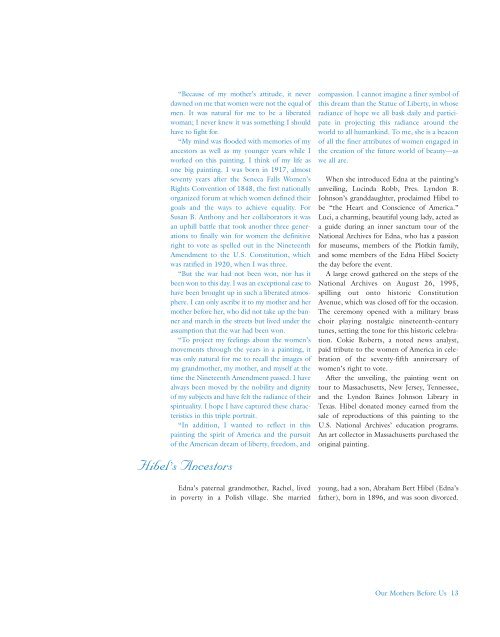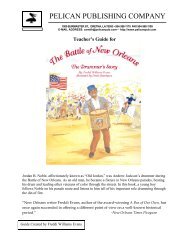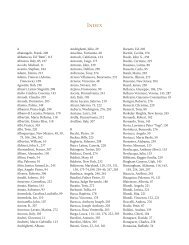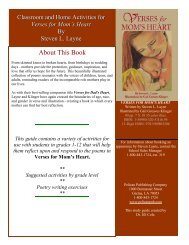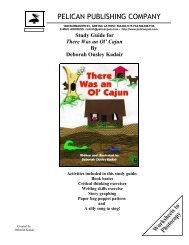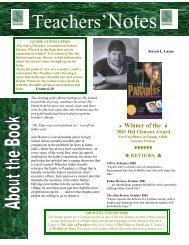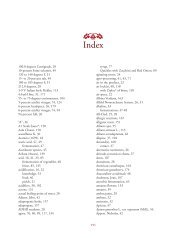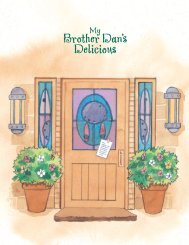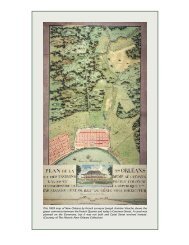Chapter 1 PDF
Chapter 1 PDF
Chapter 1 PDF
Create successful ePaper yourself
Turn your PDF publications into a flip-book with our unique Google optimized e-Paper software.
“Because of my mother’s attitude, it never<br />
dawned on me that women were not the equal of<br />
men. It was natural for me to be a liberated<br />
woman; I never knew it was something I should<br />
have to fight for.<br />
“My mind was flooded with memories of my<br />
ancestors as well as my younger years while I<br />
worked on this painting. I think of my life as<br />
one big painting. I was born in 1917, almost<br />
seventy years after the Seneca Falls Women’s<br />
Rights Convention of 1848, the first nationally<br />
organized forum at which women defined their<br />
goals and the ways to achieve equality. For<br />
Susan B. Anthony and her collaborators it was<br />
an uphill battle that took another three generations<br />
to finally win for women the definitive<br />
right to vote as spelled out in the Nineteenth<br />
Amendment to the U.S. Constitution, which<br />
was ratified in 1920, when I was three.<br />
“But the war had not been won, nor has it<br />
been won to this day. I was an exceptional case to<br />
have been brought up in such a liberated atmosphere.<br />
I can only ascribe it to my mother and her<br />
mother before her, who did not take up the banner<br />
and march in the streets but lived under the<br />
assumption that the war had been won.<br />
“To project my feelings about the women’s<br />
movements through the years in a painting, it<br />
was only natural for me to recall the images of<br />
my grandmother, my mother, and myself at the<br />
time the Nineteenth Amendment passed. I have<br />
always been moved by the nobility and dignity<br />
of my subjects and have felt the radiance of their<br />
spirituality. I hope I have captured these characteristics<br />
in this triple portrait.<br />
“In addition, I wanted to reflect in this<br />
painting the spirit of America and the pursuit<br />
of the American dream of liberty, freedom, and<br />
Hibel’s Ancestors<br />
Edna’s paternal grandmother, Rachel, lived<br />
in poverty in a Polish village. She married<br />
compassion. I cannot imagine a finer symbol of<br />
this dream than the Statue of Liberty, in whose<br />
radiance of hope we all bask daily and participate<br />
in projecting this radiance around the<br />
world to all humankind. To me, she is a beacon<br />
of all the finer attributes of women engaged in<br />
the creation of the future world of beauty—as<br />
we all are.<br />
When she introduced Edna at the painting’s<br />
unveiling, Lucinda Robb, Pres. Lyndon B.<br />
Johnson’s granddaughter, proclaimed Hibel to<br />
be “the Heart and Conscience of America.”<br />
Luci, a charming, beautiful young lady, acted as<br />
a guide during an inner sanctum tour of the<br />
National Archives for Edna, who has a passion<br />
for museums, members of the Plotkin family,<br />
and some members of the Edna Hibel Society<br />
the day before the event.<br />
A large crowd gathered on the steps of the<br />
National Archives on August 26, 1995,<br />
spilling out onto historic Constitution<br />
Avenue, which was closed off for the occasion.<br />
The ceremony opened with a military brass<br />
choir playing nostalgic nineteenth-century<br />
tunes, setting the tone for this historic celebration.<br />
Cokie Roberts, a noted news analyst,<br />
paid tribute to the women of America in celebration<br />
of the seventy-fifth anniversary of<br />
women’s right to vote.<br />
After the unveiling, the painting went on<br />
tour to Massachusetts, New Jersey, Tennessee,<br />
and the Lyndon Baines Johnson Library in<br />
Texas. Hibel donated money earned from the<br />
sale of reproductions of this painting to the<br />
U.S. National Archives’ education programs.<br />
An art collector in Massachusetts purchased the<br />
original painting.<br />
young, had a son, Abraham Bert Hibel (Edna’s<br />
father), born in 1896, and was soon divorced.<br />
Our Mothers Before Us 13


